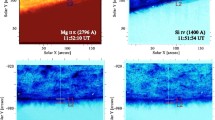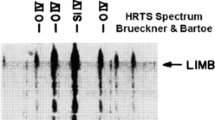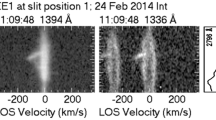Abstract
SWAP images from PROBA2 taken at 174 Å in the Fe ix/x lines are compared with simultaneous slitless flash spectra obtained during the solar total eclipse of 11 July 2010. Myriad faint low-excitation emission lines together with the He i and He ii Paschen α chromospheric lines are recorded on eclipse spectra where regions of limb prominences are obtained with space-borne imagers. We analyzed a deep flash spectrum obtained by summing 80 individual spectra to evaluate the intensity modulations of the continuum. Intensity deficits are observed and measured at the prominences boundaries in both eclipse and SWAP images. The prominence cavities interpreted as a relative depression of plasma density, produced inside the corona surrounding the prominences, and some intense heating occurring in these regions, are discussed. Photometric measurements are shown at different scales and different, spectrally narrow, intervals for both the prominences and the coronal background.














Similar content being viewed by others
Notes
From the historical point of view, flash spectra were rather long-exposure frames using photographic plates at the exit of a slitless spectrograph. They were taken just after the last Baily’s beads seen in white light, when the chromospheric lines are seen extended and are superposed on the myriad narrow low-excitation emission lines overlying the very faint photospheric continuum left outside the solar limb. The faintest lines are revealed at the coronal intensity level during total eclipse, when the level of parasitic scattered light is completely negligible.
References
Allen, C.W.: 1975, Mon. Not. Roy. Astron. Soc. 172, 159.
Bazin, C., Koutchmy, S., Tavabi, E.: 2011, In: Hady, H., Damé, L. (eds.): Proceedings of the 2nd Internat. Symp. 19, Cairo University Press, Cairo. doi: 10.1012/S120027852004 , http://iaga.cu.edu.eg .
Berghmans, D., Hochedez, J.-F., Defise, J.M., Lécat, J.H., Nicula, B., Slemzin, V.: 2006, Adv. Space Res. 38, 1807. doi: 10.1016/j.asr.2005.03.070 .
Billings, D.A.: 1966, A Guide to the Solar Corona, Academic Press, New York.
De Groof, A., Berghmans, D., Defise, J.-M., Nicula, B., Schuehle, U.: 2008b, In: Hardi, P. (ed.) 12th European Solar Physics Meeting, 2.116 Kiepenheuer-Institut für Sonnenphysik, http://espm.kis.uni-freiburg.de/ .
De Groof, A., Berghmans, D., Nicula, B., Halain, J.-P., Defise, J.-M., Thibert, T.: 2008a, Solar Phys. 249, 147. doi: 10.1007/s11207-008-9175-y .
Defise, J.-M., Halain, J.-P., Berghmans, D., Denis, F., Mazy, E., Thibert, T.: 2007, In: Fineschi, S., Rodney, A., Viereck, R.A. (eds.) Solar Physics and Space Weather Instrumentation II, Proc. SPIE 6689, 66890S. doi: 10.1117/12.731784 .
Delaboudinière, J.-P., Artzner, G.E., Brunaud, J., Gabriel, A.H., Hochedez, J.F., Miller, F., Song, X.Y., Au, B., Dere, K.P., Howard, R.A., et al.: 1995, Solar Phys. 162, 291. doi: 10.1007/BF00733432 .
Engvold, O., Hirayama, T., Leroy, J.L., Priest, E.R., Tandberg-Hanssen, E.: 1990, In: Ruzdjak, V., Tandberg-Hanssen, E. (eds.) IAU Coll. 117. Dynamics of Quiescent Prominences, Lecture Notes in Physic 363, Springer, Berlin, 294. doi: 10.1007/BFb0025709 .
Habbal, S.R., Druckmüller, M., Morgan, H., Scholl, I., Rušin, V., Daw, A.: 2010, Astrophys. J. 719, 1362. doi: 10.1088/0004-637X/719/2/1362 .
Habbal, S.R., Druckmüller, M., Morgan, H., Ding, A., Johnson, J., Druckmüllerová, H.: 2011, Astrophys. J. 734, 120. doi: 10.1088/0004-637X/734/2/120 .
Halain, J.-P., Berghmans, D., Defise, J.-M., Renotte, E., Thibert, T., Mazy, E.: 2010, In: Arnaud, M., Murray, S., Takahashi, T. (eds.) Space Telescopes and Instrumentation, Proc. SPIE 7732, 77320P. doi: 10.1117/12.857979 .
Harvey, K.: 2001, In: Murdin, P. (ed.) Encyclopedia of Astronomy and Astrophysics, Nature Publishing Group, Hampshire and Institute of Physics Publishing, Bristol. doi: 10.1888/0333750888/2268 .
Hirayama, T.: 1964, Publ. Astron. Soc. Japan 16, 104.
Hirayama, T.: 1971, Solar Phys. 17, 50. doi: 10.1007/BF00152861 .
Hirayama, T., Irie, M.: 1984, Solar Phys. 90, 291. doi: 10.1007/BF00173957 .
Hirayama, T., Nakagomi, Y.: 1974, Publ. Astron. Soc. Japan 26, 53.
Jejcic, S., Heinzel, P.: 2009, Solar Phys. 254, 89. doi: 10.1007/s11207-008-9289-2 .
Koutchmy, S., Filippov, B., Lamy, P.: 2007, In: Heinzel, P., Dorotovič, I., Rutten, R.J. (eds.) The Physics of Chromospheric Plasmas CS-368, Astron. Soc. Pac., San Francisco, 331.
Koutchmy, S., Lamy, P.: 1985, Properties and Interactions of Interplanetary Dust, Proc. IAU Colloquium 85, Reidel, Dordrecht, (A86-42326 20-90), 63.
Koutchmy, S., Lebecq, C., Stellmacher, G.: 1983, Astron. Astrophys. 119, 261.
Kubota, J., Leroy, J.-L.: 1970, Astron. Astrophys. 6, 275.
Labrosse, N., Heinzel, P., Vial, J.-C., Kucera, T., Parenti, S., Guar, S., Schmieder, B., Kilper, G.: 2010, Space Sci. Rev. 151, 243. doi: 10.1007/s11214-010-9630-6 .
November, L., Koutchmy, S.: 1996, Astrophys. J. 466, 512. doi: 10.1086/177528 .
Pasachoff, J., Rušin, V., Druckmüllerová, H., Saniga, M., Lu, M., Malamut, C.: 2011, Astrophys. J. 734, 114. doi: 10.1088/0004-637X/734/2/114 .
Saito, K., Hyder, C.: 1968, Solar Phys. 5, 61. doi: 10.1007/BF00147121 .
Saito, K., Tandberg-Hanssen, E.: 1973, Solar Phys. 31, 105. doi: 10.1007/BF00156076 .
Seaton, D.B., Berghmans, D., Nicula, B., Halain, J.P., De Groof, A., Thibert, T., Bloomfield, D.S., Raftery, C.L., Gallagher, P.T., Auchère, F., Defise, J.-M., D’Huys, E., Lecat, J.-H., Mazy, E., Rochus, P., Rossi, L., Schüle, L., Slemzin, V., Yalim, M.S., Zender, J.: 2012, Solar Phys. doi: 10.1007/s11207-012-0114-6 .
Shklovskii, I.S.: 1965, Physics of the Solar Corona, 2nd edn., Pergamon Press, Oxford, 249.
Sirk, M.M., Hurwitz, M., Marchant, W.: 2010, Solar Phys. 264, 287. ADS: 2010SoPh..264..287S . doi: 10.1007/s11207-010-9591-7 .
Stellmacher, G., Wiehr, E., Dammasch, I.E.: 2003, Solar Phys. 217, 133. doi: 10.1023/A:1027310303994 .
Tandberg-Hanssen, E.: 1995, The Nature of Solar Prominences, ASSL 199, Kluwer, Dordrecht, 308.
Tavabi, E., Koutchmy, S.: 2012, Solar Phys. doi: 10.1007/s11207-012-0011-z .
Thomas, R.J.: 2003, In: Trujillo-Bueno, J., Sanchez Almeida, J. (eds.) Solar Polarisation CS-307, Astron. Soc. Pac., San Francisco, 497.
Acknowledgements
We first address many thanks to the SWAP team for the 174 Å images, which were provided by the PROBA2 Belgium consortium and we especially thank David Berghmans and Anik De Groof for their help in organizing the collaborative GI programs; the whole ROB PROBA2 team should be congratulated for succeeding in obtaining very good SWAP sequences during the 2010 total solar eclipse. SWAP is a project of the Centre Spatial de Liège and the Royal Observatory of Belgium funded by the Belgian Federal Science Policy (BELSPO). We warmly thank the SDO/AIA teams for providing EUV high-resolution images from space that we used in this article, courtesy of NASA, see sdo.gsfs.nasa.gov and aia.lmsal.com ; we thank the laboratories involved in the development of this wonderful experiment, including the Smithsonian Astrophysical Observatory (Cambridge) and the LMSAL. We also thank the SOHO/EIT team for still providing good images after 14 years of operation, courtesy of both ESA and NASA, as a result of very successful collaborations. We thank Zadig Mouradian, Jean-Claude Vial, Götz Stellmacher, Eberhard Wiehr, Frédéric Auchère, and Philippe Lamy for discussions during the genesis of this article and later, as well as Eleni Dara and Leon Golub for reviewing it. Antoine Llebaria helped us with the IDL program to convert images into polar coordinates, M. Druckmüller provided an excellent processed eclipse image from Tatakoto, and Jean Mouette successfully took the white-light images during the total solar eclipse of 11 July 2010 in French Polynesia and processed them. Observations were supported by CNES (France), in the framework of a program to complement the data collected by the Picard mission. Finally, we sincerely thank the referee for helping us in improving the article.
Author information
Authors and Affiliations
Corresponding author
Additional information
PROBA2 – First Two Years of Solar Observation
Guest Editors: David Berghmans, Anik De Groof, Marie Dominique, and Jean-François Hochedez
Appendix: Schematic of the Flash Spectra Experiment Used in Hao French Polynesia During the 11 July 2010 Total Eclipse
Appendix: Schematic of the Flash Spectra Experiment Used in Hao French Polynesia During the 11 July 2010 Total Eclipse
Rights and permissions
About this article
Cite this article
Bazin, C., Koutchmy, S. & Tavabi, E. Prominence Cavity Regions Observed Using SWAP 174 Å Filtergrams and Simultaneous Eclipse Flash Spectra. Sol Phys 286, 255–270 (2013). https://doi.org/10.1007/s11207-012-0188-1
Received:
Accepted:
Published:
Issue Date:
DOI: https://doi.org/10.1007/s11207-012-0188-1





